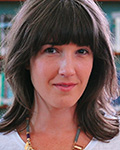2015
Lauren Applebaum
- Doctoral Candidate
- University of Illinois at Urbana-Champaign

Abstract
This dissertation examines how American art, from paintings to quilts and decorative desk sets, engaged early electronic telecommunication practices between the mid-nineteenth and early twentieth centuries. Drawing on media theory, it conceives of such objects as active agents of communication that negotiated the shifting nature of social connection bridged by new technologies like the telegraph and telephone. While the fluid transmission of information over vast distances purported to provide democratic access, works by Frederic Church, Enoch Wood Perry, John F. Peto, and Louis C. Tiffany demonstrate the uncertainty of these aspirations through their own specific media and formal tropes. Due to its precarious form, the elusive matter of electronic mediation becomes the very figure for this uncertainty. Though invisible as a raw material, its presence in the spaces between social and national bodies is deeply inscribed in material and visual culture.

